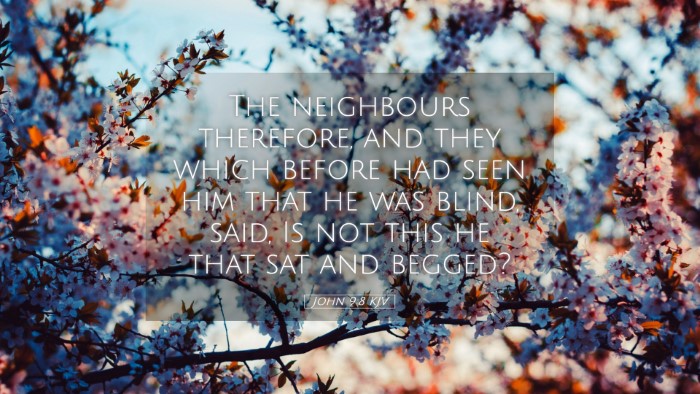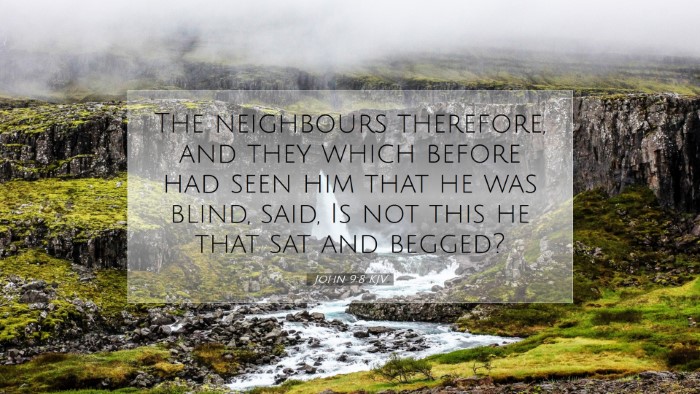Commentary on John 9:8
John 9:8 states, "The neighbors therefore, and they which before had seen him that he was blind, said, Is not this he that sat and begged?" This verse introduces a significant moment of recognition and inquiry into the identity of the man healed by Jesus. The surrounding commentary explores themes of misunderstanding, curiosity, and the profound implications of miraculous events.
Contextual Overview
In John 9, the narrative unfolds the miraculous healing of a man born blind. This passage is integral not only for its miraculous act but also for the theological implications it presents regarding Jesus’ identity and the misunderstanding of His mission.
Insights from Public Domain Commentaries
Matthew Henry's Commentary
Matthew Henry emphasizes the dramatic shift in the man's condition and the community’s reaction. He notes the following points:
- Recognition of the Healed: Henry points out that the neighbors' statement reveals their astonishment and the stark transformation of the man, highlighting how visible and undeniable the miracle was. Their question indicates a level of skepticism mingled with awe.
- Identity and Wholeness: The inquiry into the man’s identity suggests deeper themes of personal and communal recognition. Henry remarks that this moment illustrates the struggle between faith and doubt present in human nature.
- Community Dynamics: He illustrates how communal disturbance often follows extraordinary events, prompting discussion and speculation among those who witness them.
Albert Barnes' Notes on the Bible
Albert Barnes offers critical insights that help contextualize the verse:
- Social Implications: Barnes observes that the man's previous status as a beggar enhances the significance of his healing. His transition from a state of begging to wholeness symbolizes the transformative power of Christ.
- Evidence of Healing: He further argues that the neighbors’ questioning serves to authenticate the miracle. The social and physical evidence presented in the text creates a compelling case for understanding Jesus' divine authority.
- Initial Reactions: Barns notes human reactions to the miraculous tend to oscillate between acceptance and disbelief, a theme prevalent throughout the Gospels.
Adam Clarke's Commentary
Adam Clarke provides a detailed examination of the social context surrounding the miracle:
- Symbolic Representation: Clarke suggests that the event serves as a metaphor for spiritual blindness versus sight, indicating that the healing transcends mere physical restoration.
- Historical Context: He contextualizes the blindness and subsequent healing within Jewish culture, elaborating on how such a miracle challenged existing theological paradigms.
- Faith in Action: Clarke draws attention to the necessity of faith in recognizing and accepting Christ’s work, suggesting that community recognition is often interwoven with individual faith journeys.
Theological Implications
This verse encapsulates the theme of spiritual awakening, significantly critical for theological discussions. By examining the process of recognition and acceptance, believers can process their own journeys of faith:
- Recognition of God's Work: This moment calls for believers to reflect on how they recognize divine work in their lives and communities.
- Transformation and Identity: As the blind man transitioned from one identity to another, believers are encouraged to consider their own transformative encounters with Christ.
- Faith Amidst Doubt: The questioning of his identity reinforces the reality that faith often coexists with doubt, urging a deeper exploration of belief.
Conclusion
John 9:8 serves as a rich text for exploration of identity, community, and the transformative power of Christ. The insights drawn from public domain commentaries highlight the profound interplay between miraculous acts and their recognition in the community. This verse invites pastors, students, and scholars to delve into the complexities of faith, emphasizing the journey from blindness (both physical and spiritual) to the sight that comes from true recognition of the Savior.


